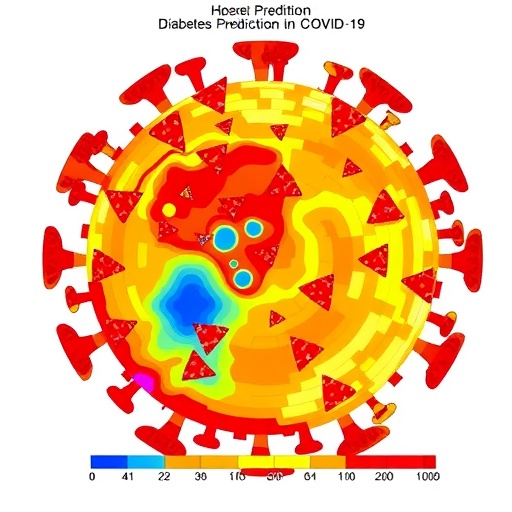In the wake of the COVID-19 pandemic, researchers have been scrambling to understand the myriad of complications that arise from the virus, particularly in vulnerable populations. Among these are individuals with newly diagnosed diabetes mellitus, a condition that has drawn significant attention due to its association with severe COVID-19 outcomes. Recent studies, including one conducted by Mohamed et al., delve into how specific biomarkers like the Triglyceride-Glucose (TyG) index, body mass index (BMI), and various inflammatory markers could serve as vital predictive tools in assessing diabetes risks in the context of COVID-19.
The TyG index, a composite measure derived from fasting triglycerides and glucose levels, has emerged as a promising indicator in metabolic syndrome research. This index not only provides insight into insulin resistance but also reflects the underlying pathophysiological mechanisms that can exacerbate diabetes in patients suffering from COVID-19. The research conducted by Mohamed and colleagues indicates that monitoring the TyG index may facilitate early identification of patients at higher risk for developing diabetes, particularly in those experiencing severe forms of the virus.
One of the striking findings from the study is the correlation between elevated BMI and the severity of COVID-19 symptoms in newly diagnosed diabetic patients. Obesity, characterized by excess body fat, is known to impair glucose homeostasis and increase the burden on the immune system. In the context of COVID-19, individuals with high BMI not only face heightened risks of hospitalizations but may also experience more pronounced metabolic dysfunctions, making them susceptible to acquiring diabetes during or after their COVID-19 recovery. The implications of this link could transform how healthcare professionals approach weight management in high-risk populations.
Inflammatory markers also play a pivotal role in predicting diabetes outcomes during COVID-19. Conditions like systemic inflammation can lead to insulin resistance, a hallmark of diabetes. The study underscores that certain markers such as C-reactive protein (CRP) and interleukins become elevated as the body responds to viral infection, which could concurrently raise the risk of diabetes. Understanding this dual-faceted relationship between inflammation, viral load, and metabolic disease lays the groundwork for new preventive strategies and treatment paradigms.
The integration of multiple biomarkers in predictive modeling not only enhances diagnostic accuracy but also optimizes treatment pathways for patients. Mohamed et al. underscore the significance of developing algorithms that utilize these markers to stratify patient risk levels effectively. As healthcare systems become overwhelmed with the complexities introduced by COVID-19, it becomes increasingly imperative to pinpoint individuals at risk for both acute viral complications and chronic conditions like diabetes.
As clinicians become more aware of the interconnectedness between COVID-19 and metabolic diseases, they are equipped with the knowledge to intervene sooner. The predictive diagnostic models proposed could help prioritize individuals who require closer monitoring and proactive management, potentially reducing hospital admissions and improving overall patient outcomes. Early identification remains crucial, especially as the likelihood of long-term health complications increases with each passing day of pandemic recovery.
Furthermore, this research emphasizes the need for interdisciplinary collaboration in tackling the ramifications of COVID-19. By engaging endocrinologists, infectious disease specialists, and public health experts, a more contingent and cohesive approach can be developed. Such collaborations are expected to shape future clinical guidelines and health policies which will further support the early detection and management of diabetes in patients recovering from COVID-19.
Another critical angle addressed in the study is the socio-economic dimension surrounding diabetes diagnosis amidst a pandemic. Many individuals diagnosed with diabetes during the crisis may also belong to underrepresented communities that historically face healthcare disparities. Addressing these inequities is paramount, as they could exacerbate the public health crisis if not adequately managed. The implications of systematic outreach and targeted interventions are essential in reducing the burden of diabetes on vulnerable populations.
As we continue to grapple with the consequences of COVID-19, the findings from Mohamed et al. present a timely reminder of the intricate relationships between viral infections and chronic conditions. This study not only aids in understanding how to better manage patients during such crises but also lays the foundation for future research aimed at elucidating these complex interactions further. It beckons the scientific community to prioritize investigations into metabolic syndromes and their implications during pandemics.
Finally, the urgency of this research cannot be overstated. The clear need for effective predictive models in clinical settings emerges as a pressing priority in the management of COVID-19’s long-term effects. It invites the healthcare community to rally around collaborative research, leading to innovative solutions that could forecast and mitigate adverse outcomes for patients stricken by diabetes following COVID-19. Indeed, the landscape of diabetes management in the aftermath of this pandemic necessitates innovative thinking rooted in vast epidemiological data, paving the way for advancements in public health.
In conclusion, the work of Mohamed et al. significantly contributes to the evolving narrative around COVID-19 and diabetes, revealing potential pathways for early diagnostics and tailored interventions. The intersection of biochemistry, epidemiology, and clinical practice, against the backdrop of a global pandemic, demands a reevaluation of how we approach such chronic diseases. As further data emerges, the hope is that these findings will inspire a renewed focus on comprehensive care models that integrate effective diabetes management into the broader context of viral illness recovery. This could not only save lives but also enhance the quality of life for millions of individuals navigating the complexities introduced by the COVID-19 era.
Subject of Research: The role of TyG Index, BMI, and inflammatory markers in predicting newly diagnosed diabetes mellitus in moderate to severe COVID-19 patients.
Article Title: Predictive diagnostic models for newly diagnosed diabetes mellitus in moderate to severe COVID-19: the role of TyG Index, BMI, and inflammatory markers.
Article References:
Mohamed, F., Gunter, S., Yirdaw, B.E. et al. Predictive diagnostic models for newly diagnosed diabetes mellitus in moderate to severe COVID-19: the role of TyG Index, BMI, and inflammatory markers. BMC Endocr Disord 25, 245 (2025). https://doi.org/10.1186/s12902-025-02056-2
Image Credits: AI Generated
DOI: 10.1186/s12902-025-02056-2
Keywords: COVID-19, diabetes mellitus, TyG index, BMI, inflammatory markers, predictive models, metabolic syndrome, health disparities, public health.
Tags: biomarkers for diabetes assessmentBMI and COVID-19 severityCOVID-19 complications in vulnerable populationsDiabetes prediction in COVID-19early identification of diabetes riskinflammation markers and diabetesinsulin resistance in COVID-19 patientsmetabolic syndrome and COVID-19newly diagnosed diabetes mellitus and COVID-19obesity and COVID-19 outcomesrisk factors for diabetes in COVID-19triglyceride-glucose index





